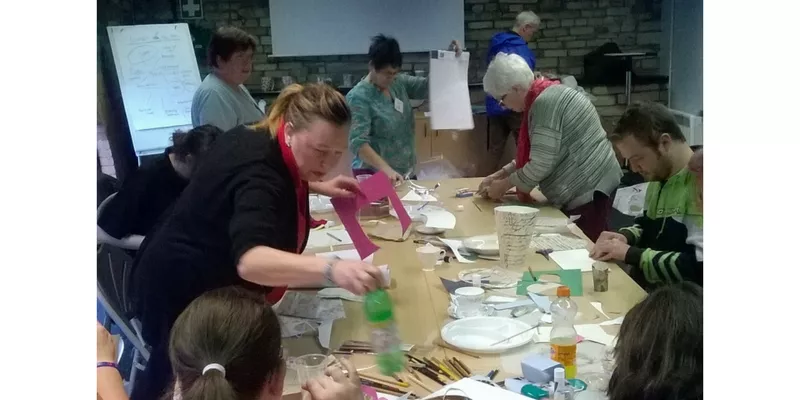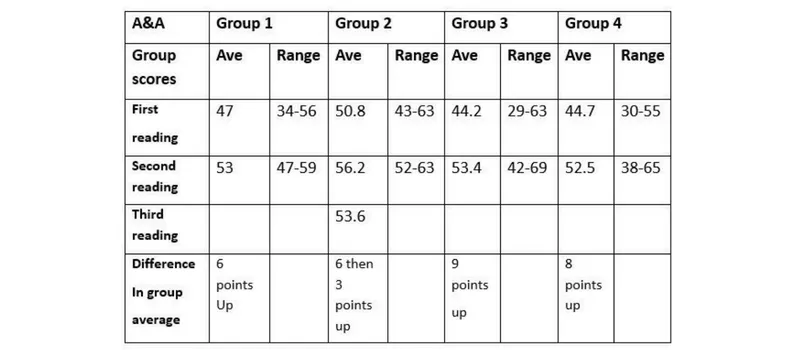Healthy Communities Art & Artefact Project


Author: Lucy Bateman, freelance project coordinator for Rhondda Cynon Taf County Borough Council, Art & Artefact Project.
In 2016/17 as part of their Tackling Poverty Programme1, Rhondda Cynon Taff County Borough Council (RCTCBC) Arts Service worked with Communities First2 to deliver a series of artist led workshops in local museums. These workshops were open to people in the community who had experienced anxiety, stress, social isolation and other mental health problems.
Four sets of workshops were run in three different museums3, being the Cynon Valley Museum, Pontypridd Museum4 and Rhondda Heritage Park5.
Each set of workshops were led by a commissioned artist and supported by RCTCBC Heritage Service staff and/or Independent Museum Managers.
The participants were recruited by Communities First engagement officers from the eight Communities First Cluster6 groups across Rhondda Cynon Taf.
Each of the four sets of workshops were preceded by an initial introductory session offering potential participants an opportunity to meet the artists involved and to see the museum and workshop space before committing themselves to the series of 8 or more Art & Artefact sessions. The work produced by each group went on display in their respective museums with all four groups joining together in producing a final exhibition at the Rhondda Heritage Park.
Evaluation of the four Art & Artefact projects was based on a mixture of qualitative and quantitative information gathered from the participants and partner organisations throughout the project.
Case Study: HK
HK with her husband MK. HK has a history of physical ill health needing wheelchair support when not in the house. Now after many years working and looking after his wife MK is suffering from vascular dementia. This degenerate condition has reversed their habits and now HK is caring for MK.
Taking part in the museum based project stimulated MK’s memories of working in the mining industry. Sitting in Pontypridd Museum MK could regale the group with tales of his life that his wife had not heard for some time. This insight to a shared life she thought he had lost made HK very happy.
“...I didn’t know it was still there...now when we go back home he talks about these things (artefacts in the collection) he talks to us about it all.” HK
Regularly getting out of the house was part of HKs role caring for her husband but it was also beneficial to her own health. Taking part in the Art & Artefact project along with other Community First activities helped increase HK’s mobility over the months. The help they received from Communities First and the others enabling their taking part each week was deeply appreciated by HK & MK
HK & MKs daughter and their Dementia Care Nurse both commented on the improvement of MKs memory and the increased wellbeing of HK since they started taking part in the project and other groups.
Outcomes from HK participation:
- Increased mobility and dexterity.
- Building positive links with local support agencies.
- Growing confidence in creative skills.
- Developed interest in community projects.
- Maintained independence.
Quantitative evaluation
The quantitative evaluating of creative projects such as this can be problematic. Quantitative information to look at the participants perceived levels of wellbeing were gathered using the Warwick Edinburgh Mental Well Being Scale (WEMWBS)7. This recognised outcome measurement tool asks participants to assess their own feelings of wellbeing.
For most of the participants the question based forms were used at the beginning and end of their Art & Artefact workshop run. The same questions were asked a third time with the Pontypridd group. The third reading with group 2 shows a slight drop in individual and group score. This important reflective score taken after the participation has ended indicates the way in which WEMWBS could be used in future projects to look at the long-term intervention this sort of project has.

Many of the people involved in this project were noticeably below the national individual average of 53 points at the first reading. This average is based on the largest survey done with this method of data collection published so far8. A couple of people within the groups were in contrast very high on their scores, this makes group averages higher in some cases than expected. This is compounded by the tendency for the participants who dropped out of the project to have low scores. This gives any group average scores a skewed positivity.
Interpreting WEMWBS scores is currently designed to look at group scores not the individuals score in isolation. However, in this project it is worth noting that of the 27 people who filled in at least 2 of these wellbeing questionnaires, 21 showed significant positive change in their scores and 2 showed negative significant change. Significant being a shift of more than 3 points either way9.

Author:
Lucy Bateman is the freelance project coordinator working for Rhondda Cynon Taf County Borough Council with the Art & Artefact Project. Lucy also acts as an Art Development Officer for Inside Out Cymru and enjoys a successful career as a self-employed freelance community artist.
1http://gov.wales/topics/people-and-communities/tackling-poverty/?lang=en
2http://www.rctcbc.gov.uk/EN/GetInvolved/CommunitiesFirstnew/CommunitiesFirst.aspx
3https://www.facebook.com/cynonvalleymuseum/
4http://pontypriddmuseum.cymru/
5http://www.rctcbc.gov.uk/EN/Tourism/RhonddaHeritagePark/Home.aspx
7http://www2.warwick.ac.uk/fac/med/research/platform/wemwbs/





